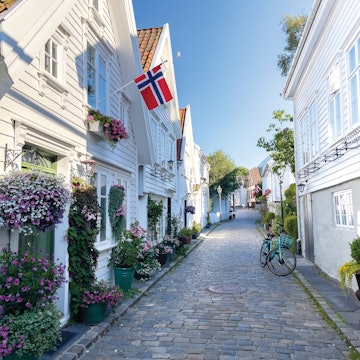

Gaining access to Norway's towns, mountains and fjords isn't too tricky for most travelers © Peter Sundt / 500px
Like most countries in the Schengen area, Norway is easy to travel to if you’re from a country within the EU or EEA. If you live elsewhere, your dream trip to the land of the fjords, Vikings and northern lights could take a little more planning and may require a tourist visa.
Here's everything you need to know about tourist visa requirements for Norway, including information about Schengen visas, how much it costs and how to apply.
What is the Schengen area?
Although Norway is not a member of the EU, it is a member of the EEA, and it’s one of the 26 countries that form the Schengen area.
When you’re granted a visa to any of the countries in the Schengen zone, your visa is also valid for travel to any of the other Schengen countries. This is why you’ll often hear the term “Schengen visa.”
The countries in the Schengen area are:
Austria, Belgium, Croatia, Czech Republic, Denmark, Estonia, Finland, France, Germany, Greece, Hungary, Iceland, Italy, Latvia, Liechtenstein, Lithuania, Luxembourg, Malta, The Netherlands, Norway, Poland, Portugal, Slovakia, Slovenia, Spain, Sweden and Switzerland.
You’ll need to go through passport control when you’re entering and leaving the Schengen area. You don’t usually have to show your passport when you’re crossing the border between Schengen countries.

Who doesn't need a visa to travel to Norway?
EU/EEA citizens
If you’re a citizen or recognized resident of an EU or EEA country (and Switzerland), you don’t need a tourist visa to travel to Norway, and you can stay for up to three months.
There’s no minimum period of time you have to wait before you can return, but you must have proof that you’ve left the country. You’ll need a valid travel document to visit, such as a European Union ID card or passport.
Citizens of other countries
Norway also has agreements with several countries outside of the EU/EEA, allowing their citizens to travel to Norway without a visa. These countries include the United Kingdom, USA, Canada, Mexico, Australia, New Zealand and Japan, among others.
Even if you don’t require a visa to travel to Norway, you need to be aware of some conditions for visiting. These include:
you can stay in any of the countries in the Schengen area (including Norway) for a combined total of 90 days in any 180-day period
your passport must be valid for at least three months after you leave Norway
you must have means of traveling back to your country of residence
you should not be planning to work
you should have at least NOK 500 for each day you’re staying in Norway.
This isn’t an exhaustive list – be sure to check the Norwegian Directorate of Immigration (UDI) website for full details before you travel.

Travelers who need a visa
If you want to travel to Norway as a tourist and you’re not on the visa-free list, you’ll need to apply for a visitor’s visa. Citizens of countries including China, India and South Africa require a visa to travel to Norway.
The following general guidance applies to most countries. Check the specific requirements for your country, including current visa costs, at udi.no.
Applying for a visa
To apply for a visitor’s visa, you’ll normally need to register your application online and then visit a Norwegian embassy, consulate, or Visa Application Center in person with all the required documents.
A visitor’s visa is valid for travel throughout the Schengen area – including Norway – for up to 90 days in any 180-day period. You should submit your visa application at least four weeks in advance, but you can apply up to six months before your trip.
If you’re traveling to several Schengen countries on the same trip, you should apply for a visa for your main destination. This is normally the country you’re staying in the longest or the one you’ll be arriving at.
When you apply, you’ll need to state how many entries you require on your visa. This is especially important if you’re going on a multi-country trip that involves traveling outside of the Schengen area (for example, to the UK or Russia), and then returning.
At the time of writing, the standard fee for a visitor’s visa is €80 for adults and children over 12 years old.
Extending your visa
Schengen visas (and therefore visas for Norway) cannot be extended. Once you’ve reached 90 days, you must leave the Schengen area or apply for a residence permit.
If you’ve left the Schengen zone and want to re-enter, but you’ve used up the number of entries on your original visa, you’ll need to apply for a new Schengen visa.
Working holiday visa in Norway
Norway doesn’t have a specific working holiday visa scheme, but seasonal workers in some industries, for example in agriculture, can be granted special permits.
That said, Visit Norway does promote traveling to the country for a “workation.” This means that you could work as a digital nomad, doing your regular job remotely from the fjords or deep within the Arctic Circle. Be sure to check the conditions of your own visa before traveling for this purpose.
Traveling to Svalbard
Although Svalbard is a Norwegian territory, it has different rules for travel than the rest of the country. In particular, Svalbard is not in the Schengen area, but you’ll have to travel through the zone to reach it. If you plan to go to Svalbard, make sure that you have enough entries on your visa to cover your visit. For more information, visit sysselmesteren.no.















